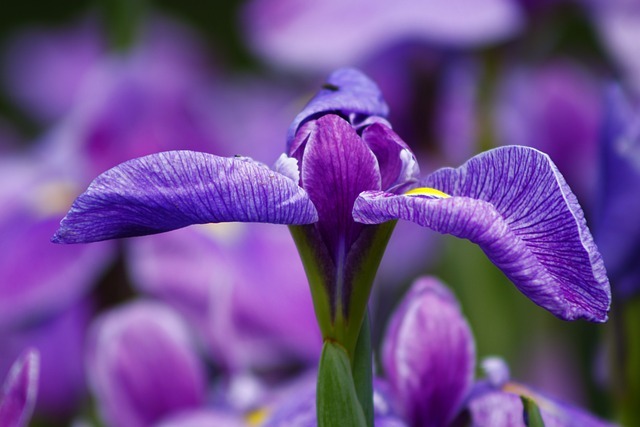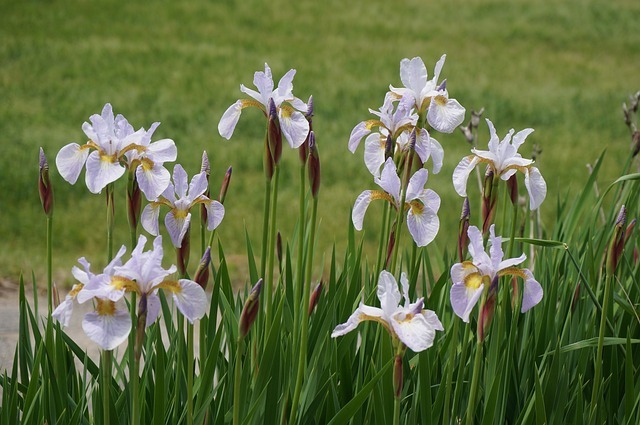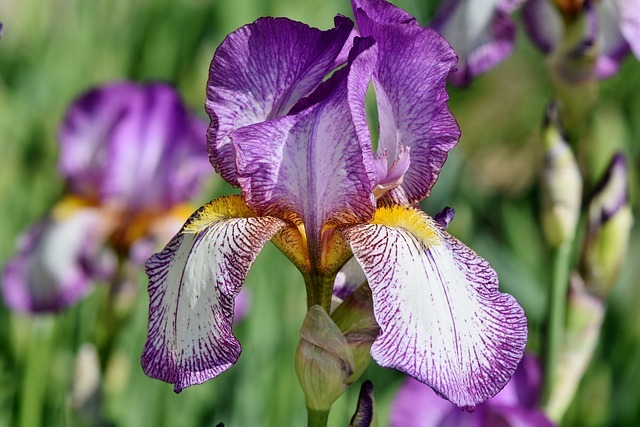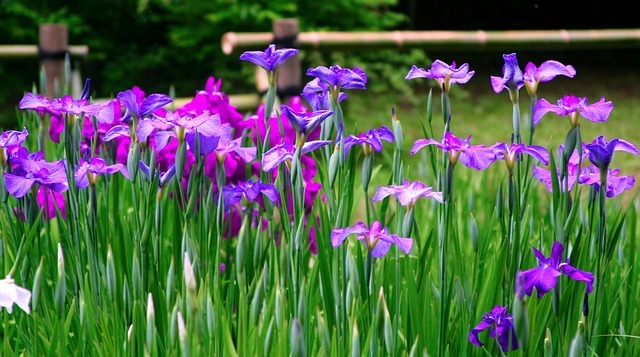Japanese irises are among the most elegant and stunning flowering plants available to gardeners, known for their spectacular blooms and graceful form. Native to Japan but beloved worldwide, these magnificent perennials offer a symphony of colors from deep purples and blues to delicate whites and multicolored varieties. Unlike many other garden flowers, Japanese irises thrive in moist conditions, making them perfect for areas where other plants might struggle. With proper care, these showstoppers can transform ordinary garden spaces into extraordinary displays of natural beauty that captivate visitors during their blooming season.
What are Japanese Irises?

Japanese irises, scientifically known as Iris ensata (formerly called Iris kaempferi), are distinctive flowering plants with a rich cultural heritage stretching back centuries. In Japan, they are called “Hanashobu” (花菖蒲), which literally translates to “flower iris,” indicating the high esteem in which they are held.
Historically, Japanese irises have been cultivated in Japan for over 500 years, with references in Japanese literature and art dating back to at least the 12th century. Initially reserved for enjoyment by royalty only, they have since become beloved garden plants worldwide. Throughout centuries of cultivation, Japanese gardeners have developed more than 2,000 cultivars from the original wild plants.
What makes Japanese irises distinctive is their flower structure. Unlike bearded irises, Japanese irises are beardless and feature wide, flat falls (the downward-pointing petals) with small standards (upright petals), giving them a more horizontal, elegant appearance. Their blooms are extraordinarily large, sometimes reaching 8-10 inches across, and appear in an array of colors including purple, blue, white, pink, and various bicolors with intricate veining patterns.
It’s important to note that in Japan, the term “Japanese iris” actually encompasses three species:
- Hanashobu (Iris ensata) – The water-loving variety most commonly referred to as “Japanese iris” outside Japan
- Kakitsubata (Iris laevigata) – Another water iris with a distinctive white streak near the center
- Ayame (Iris sanguinea) – A dry-land iris that blooms earlier than the other two
Japanese Iris vs. Siberian Iris: Key Differences
While both Japanese and Siberian irises are popular beardless varieties, they have distinct characteristics that gardeners should understand before planting. Here’s a comparison of their key differences:
| Feature | Japanese Iris (Iris ensata) | Siberian Iris (Iris sibirica) |
|---|---|---|
| Flower Size | Enormous, up to 8-10 inches across | Smaller, more delicate flowers |
| Flower Shape | Flat, wide falls with small standards | More traditional iris shape with pronounced standards |
| Foliage | Broad, sword-like leaves with a distinct center rib | Narrow, grass-like foliage |
| Height | 24-48 inches tall | 24-40 inches tall |
| Bloom Time | Later blooming (June-July) | Earlier blooming (May-June) |
| Water Needs | Requires consistent moisture, thrives in wet areas | Moisture-loving but more drought-tolerant once established |
| Soil Preference | Prefers acidic soil (pH 5.0-6.5) | Adaptable to various soil types |
| Longevity | Needs division every 3-4 years | Extremely long-lived, can thrive for decades |
| Foliage After Bloom | Remains attractive, with distinct center rib | Maintains ornamental grass-like appearance |
While Japanese irises are often mistakenly considered bog plants, they actually prefer consistently moist soil but don’t want to stand in water during winter. Siberian irises are more forgiving in terms of water requirements but won’t tolerate extreme drought.
Popular Japanese Iris Varieties

Japanese iris breeding has led to a remarkable diversity of varieties, with thousands of cultivars available. Here are some of the most notable types:
- ‘Rose Queen’ – Award-winning variety with large, rose-pink blooms
- ‘Variegata’ – Features attractive variegated foliage along with beautiful flowers
- ‘Amethyst’s Sister’ – Tall variety reaching over four feet with stunning purple blooms
- ‘Freckled Peacock’ – Distinguished by unique speckled patterning on the petals
- ‘Imperial Magic’ – Rich purple blooms with yellow signals and white veining
- ‘Moonlight Waves’ – Elegant white flowers with ruffled edges
- ‘Blue Spritz’ – Light blue petals with darker veining and speckles
- ‘Dancing Waves’ – Double flowers with ruffled edges in lavender-pink
- ‘Lion King’ – Bold purple-red blooms with dramatic yellow signals
Japanese irises are commonly classified by their place of origin:
- Edo (Tokyo) strain – Includes the oldest and less developed forms
- Higo (Kumamoto Prefecture) strain – Considered by many to produce the finest blooms
- Ise (Mie Prefecture) strain – Known for distinctive characteristics
- American strain – Developed in the United States
Flower forms also vary widely, including single (3 falls), double (6 falls), and peony-flowered varieties, each offering their own distinctive charm.
Growing Japanese Iris: Ideal Conditions
Soil Requirements
Japanese irises are particular about their soil. They prefer rich, acidic soil with a pH between 5.0 and 6.5. Neutral or alkaline soils will cause the plants to decline over time, with yellowing leaves being a common sign of unsuitable pH levels.
The soil should be:
- Rich in organic matter
- Loose and friable (not compacted)
- Consistently moist but well-drained
- Slightly acidic
If your natural soil doesn’t meet these requirements, amend it with peat moss, well-rotted manure, and compost. Avoid using mushroom compost as it typically contains lime, which can raise the soil pH.
Sun or Shade Preference
Japanese irises perform best in full sun to partial shade. In cooler northern climates, they appreciate full sun (at least 6 hours daily). In warmer southern regions, some afternoon shade is beneficial to protect the plants from intense heat.
The amount of sunlight directly affects blooming – insufficient light will result in lush foliage but few flowers. For the most spectacular blooms, ensure your Japanese irises receive adequate sunlight.
Water Needs
Perhaps the most critical factor for success with Japanese irises is consistent moisture. Unlike many garden plants, they prefer wet conditions:
- They need abundant water during the spring growing season
- Keep soil consistently moist throughout the summer blooming period
- Reduce watering somewhat in fall and winter, but never let them dry out completely
- Ideally, water should be slightly acidic (if your water is alkaline, adding 2-3 teaspoons of vinegar per gallon can help)
While they appreciate moisture, Japanese irises should not sit in standing water during the winter months, as this can cause the rhizomes to rot. They’re perfect for planting near water features, in rain gardens, or in areas that remain damp but not waterlogged.
Planting and Propagation

When to Plant
The optimal time to plant Japanese iris is in early fall, which gives the plants time to establish before winter. However, they can be planted from spring through fall as long as they’re kept adequately watered and temperatures remain below 90°F for about a month after planting.
In warmer regions with hot summers, fall planting is generally more successful as it allows the plants to establish during cooler weather.
How to Plant
Follow these steps for successful planting:
- Prepare the soil by incorporating ample organic matter
- Soak the rhizomes in water overnight before planting
- Dig a hole about 3-5 inches deep
- Position the rhizome with roots spread out and pointing downward
- Plant with the crown (where leaves and rhizome meet) 1-2 inches below soil level
- Space plants 12-18 inches apart
- Water thoroughly after planting
- Apply mulch to retain moisture and prevent winter heaving
For container planting, choose a large, wide pot with good drainage holes and use high-quality, humus-rich potting soil. Container-grown irises will need extra protection during winter in colder climates.
Dividing Japanese Iris
Japanese irises benefit from division every 3-4 years to maintain vigor and flowering. Signs that division is needed include:
- Decreased flowering
- Center of the clump becoming woody or bare
- Overcrowded growth
The best time to divide is shortly after flowering in late summer:
- Dig up the entire clump
- Cut back the foliage to about 6 inches
- Wash soil from the rhizomes
- Cut the rhizome into sections with 2-4 fans each
- Replant immediately in freshly prepared soil
- Keep well-watered until established
Never let the rhizomes dry out during the division process.
Seasonal Care Guide
Spring and Summer Care
Spring and summer are the most active growing periods for Japanese iris:
- Early spring: Apply a high-nitrogen fertilizer as new growth appears
- Keep soil consistently moist throughout spring and summer
- Apply a second fertilization just after blooming
- Remove spent flowers promptly to prevent seed formation
- Watch for pests such as aphids, iris borers, snails, and slugs
- Treat with appropriate insecticidal soaps or pesticides if needed
Fall and Winter Care
Proper fall and winter care ensures your Japanese irises survive the cold months and bloom beautifully the following year:
- Reduce watering in fall, but don’t let plants dry out completely
- Avoid standing water around rhizomes during winter
- Cut back foliage in late fall after it has died back naturally
- Apply a winter mulch in colder regions to prevent frost heaving
- For container plants, provide extra winter protection by burying pots or moving to a protected location
Getting Japanese Iris to Bloom
If your Japanese iris isn’t blooming well, consider these factors:
- Insufficient sunlight – Ensure at least 6 hours of sun daily
- Improper soil pH – Test and amend soil to maintain acidity
- Inadequate nutrition – Apply appropriate fertilizer in spring and after blooming
- Overcrowded plants – Divide clumps every 3-4 years
- Inconsistent moisture – Maintain even soil moisture, especially in spring
- Planting depth – Rhizomes planted too deeply may not bloom well
- Immature plants – New divisions may take a year to establish before blooming well
With proper attention to these factors, Japanese irises can provide spectacular blooms year after year.
Japanese Iris in Traditional Gardens

In Japan, irises hold special cultural significance and are incorporated into garden design with thoughtful intention. They are often featured in traditional Japanese gardens, particularly near water features where their reflection enhances their beauty.
During the Edo period (1603-1868), specialized iris gardens called “Hana Shobu-en” emerged, dedicated to displaying the most exquisite varieties. These gardens continue to attract visitors today during the blooming season, similar to the cherry blossom viewing tradition.
Japanese garden design principles for iris placement include:
- Planting in groups rather than individually
- Placing near zigzag (yatsuhashi) bridges over water
- Creating view corridors that highlight the flowers
- Using irises as focal points in pond-edge plantings
- Combining with architectural elements like stone lanterns
These design techniques can be adapted for Western gardens to create contemplative spaces with Japanese aesthetic influences.
Famous Japanese Iris Gardens in Japan

Japan boasts numerous magnificent gardens where visitors can witness thousands of iris blooms in season. Some of the most renowned include:
- Meiji Shrine Inner Garden (Tokyo) – Features around 1,500 iris plants in bloom during June, set in the serene garden of this famous shrine.
- Horikiri Iris Garden (Tokyo) – A historic garden with 6,000 irises of 200 different species, featured in Utagawa Hiroshige’s famous “One Hundred Famous Views of Edo” prints.
- Mizumoto Park (Tokyo) – Home to an impressive collection of 200,000 iris plants that create a spectacular display when in bloom.
- Suigo Sawara Ayame Park (Chiba) – Hosts an annual iris festival featuring 1.5 million flowers and offers workshops on iris propagation.
- Yokosuka Iris Garden (Kanagawa) – One of Japan’s largest iris gardens with approximately 140,000 flowers.
- Eitaku-ji Iris Garden (Hyogo) – A temple garden where hanashobu have grown wild for over 600 years.
- Yatsuhashi Kakitsubata Garden (Aichi) – Famous specifically for Kakitsubata iris (Iris laevigata) with thousands of plants.
These gardens typically reach peak bloom in late May through June, coinciding with Japan’s rainy season. Many hold annual iris festivals (matsuri) that attract thousands of visitors who come to appreciate the exquisite beauty of these beloved flowers.
Summary
Japanese irises offer gardeners a unique combination of spectacular beauty and distinctive growing requirements. With their enormous, flat blooms in a rainbow of colors, they provide a different aesthetic than other iris types and can become the highlight of a garden’s summer display.
Success with these magnificent plants comes from understanding their needs:
- Acidic, organic-rich soil
- Consistent moisture
- Adequate sunlight
- Regular division every few years
- Proper seasonal care
By providing these conditions, gardeners worldwide can enjoy the same breathtaking displays that have captivated the Japanese for centuries. Whether incorporated into a water garden, planted in mixed borders, or featured in containers, Japanese irises reward dedicated gardeners with a truly enchanting flowering performance that few other perennials can match.
Beyond their ornamental value, growing Japanese irises connects gardeners to centuries of horticultural tradition and artistic appreciation, making them not just beautiful garden specimens but living cultural treasures.


